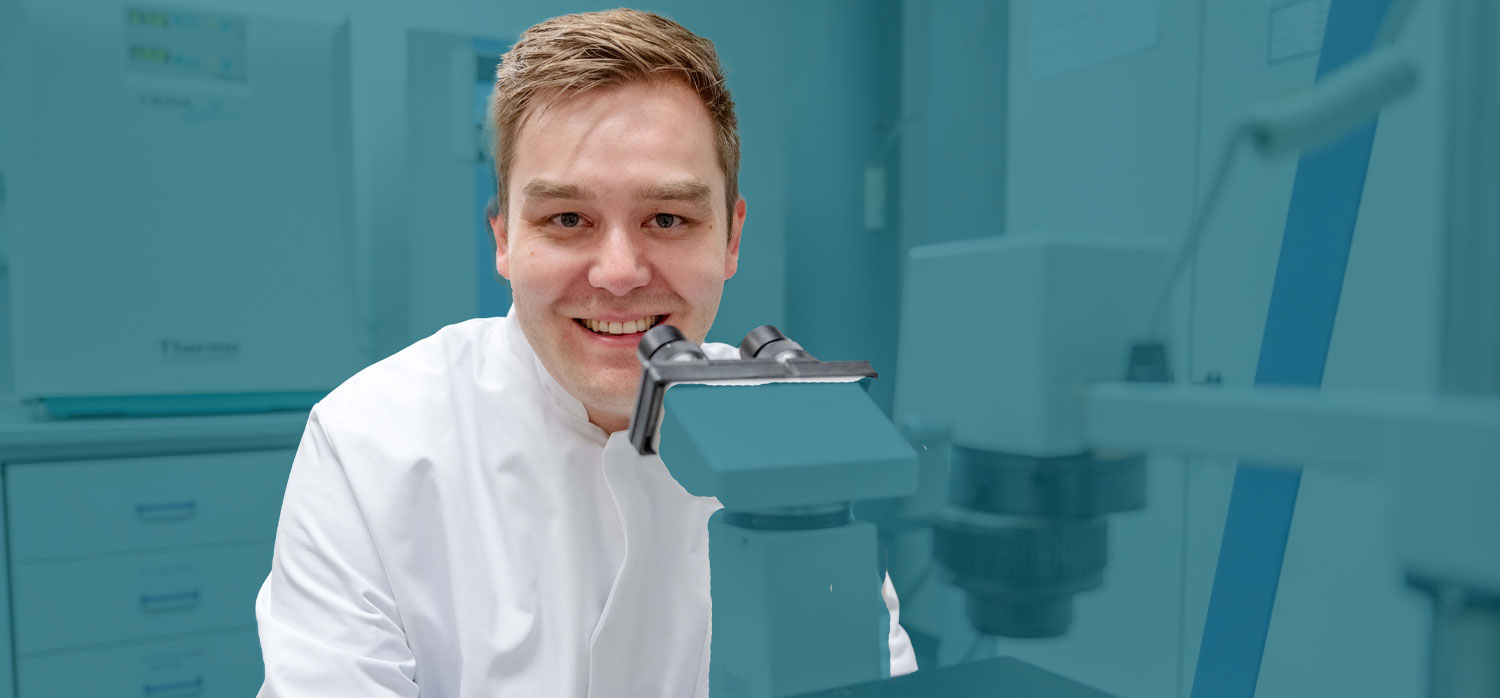Press

How gut bacteria educate our immune system and how cancer drugs can be remote-controlled
This year's Paul Ehrlich and Ludwig Darmstaedter Prizes will be awarded at Paulskirche in Frankfurt today
Physician and immunologist Dennis L. Kasper (81) of Harvard Medical School will receive the Paul Ehrlich and Ludwig Darmstaedter Prize 2024, endowed with €120,000, in a ceremony held in Frankfurt's Paulskirche today. The award recognizes his discovery of the first words of the biochemical language through which bacteria that populate our colon educate our immune system, thereby ensuring its healthy development. The Early Career Award goes to chemist Johannes Karges (31) from Ruhr University Bochum for his invention of a process with which highly effective chemotherapeutic agents can only accumulate in the tumor and can only be activated there by irradiation with light or ultrasound.
FRANKFURT. Around ten trillion bacteria live in the large intestine of every human being, which, for the most part, act as guarantors of our health. This is because over the course of evolution, relationships have developed between bacteria and their hosts from which both benefit. In return for finding an ideal habitat in the gut, the bacteria defend us against their pathogenic relatives, provide us with vitamins and nutrients or help us with digestion. This symbiosis can only succeed through continuous communication between our intestinal bacteria and our immune system. Dennis L. Kasper has decoded the first words and rules of the language in which this communication takes place. He discovered that certain bacterial molecules act as educators of the immune system and teach it not to attack useful bacteria or cells of its own body, i.e. to maintain a healthy balance between tolerance and aggression. "Dennis Kasper is the first person to succeed in uncovering communication channels in the superorganism formed by humans and their microbiome," explains, Prof. Dr. Thomas Boehm, Chairman of the Scientific Council of the Paul Ehrlich Foundation. "In doing so, he has opened the door to a field of research in which new approaches for the treatment of autoimmune diseases are already emerging."
Cisplatin and two of its derivatives are the world's most common cancer drugs. While they show impressive success against certain types of cancer, at the same time, they quickly bring about resistance. In addition, given that they also inhibit the division of healthy body cells, they cause serious side effects. The winner of this year's Paul Ehrlich and Ludwig Darmstaedter Early Career Award, Johannes Karges, has developed a process that allows platinum-containing drugs to act exclusively in the tumor. To do so, he packages them in nanoparticles that only accumulate in the cancer tissue, where they are then activated by external irradiation with light or ultrasound. In this way, he can precisely control the use of certain cytostatic drugs in terms of both space and time – like remote-controlled magic bullets that, in the spirit of Paul Ehrlich, selectively cure the disease without harming the rest of the body. The prizewinner has already provided preclinical proof of his concept, whose translation into clinical practice could significantly increase both the efficacy and tolerability of many chemotherapies.
Paul Ehrlich and Ludwig Darmstaedter Prize 2024
Johannes Karges studied chemistry in Marburg and London and conducted research as a doctoral student in Paris and Guangzhou. As a postdoctoral researcher, he worked at the University of California, San Diego, in La Jolla. Since November 2022, he has headed a research group at Ruhr University Bochum as a Liebig Fellow of the Chemical Industry Fund. https://www.kargesgroup.ruhr-uni-bochum.de/
Further information
Press Office of the Paul Ehrlich Foundation
Joachim Pietzsch | Phone: +49 (0)69 36007188 | E-mail: j.pietzsch@wissenswort.com
FRANKFURT. Around ten trillion bacteria live in the large intestine of every human being, which, for the most part, act as guarantors of our health. This is because over the course of evolution, relationships have developed between bacteria and their hosts from which both benefit. In return for finding an ideal habitat in the gut, the bacteria defend us against their pathogenic relatives, provide us with vitamins and nutrients or help us with digestion. This symbiosis can only succeed through continuous communication between our intestinal bacteria and our immune system. Dennis L. Kasper has decoded the first words and rules of the language in which this communication takes place. He discovered that certain bacterial molecules act as educators of the immune system and teach it not to attack useful bacteria or cells of its own body, i.e. to maintain a healthy balance between tolerance and aggression. "Dennis Kasper is the first person to succeed in uncovering communication channels in the superorganism formed by humans and their microbiome," explains, Prof. Dr. Thomas Boehm, Chairman of the Scientific Council of the Paul Ehrlich Foundation. "In doing so, he has opened the door to a field of research in which new approaches for the treatment of autoimmune diseases are already emerging."
Cisplatin and two of its derivatives are the world's most common cancer drugs. While they show impressive success against certain types of cancer, at the same time, they quickly bring about resistance. In addition, given that they also inhibit the division of healthy body cells, they cause serious side effects. The winner of this year's Paul Ehrlich and Ludwig Darmstaedter Early Career Award, Johannes Karges, has developed a process that allows platinum-containing drugs to act exclusively in the tumor. To do so, he packages them in nanoparticles that only accumulate in the cancer tissue, where they are then activated by external irradiation with light or ultrasound. In this way, he can precisely control the use of certain cytostatic drugs in terms of both space and time – like remote-controlled magic bullets that, in the spirit of Paul Ehrlich, selectively cure the disease without harming the rest of the body. The prizewinner has already provided preclinical proof of his concept, whose translation into clinical practice could significantly increase both the efficacy and tolerability of many chemotherapies.
Paul Ehrlich and Ludwig Darmstaedter Prize 2024
Dennis L. Kasper has been William Ellery Channing Professor of Medicine since 1989 and Professor of Immunology at Harvard Medical School since 1997. He is co-editor of Harrison's Principles of Internal Medicine (currently in its 22nd edition), the world's most widely used medical textbook, of which he was editor-in-chief for the 16th and 19th editions. https://kasperlab.hms.harvard.edu/
Johannes Karges studied chemistry in Marburg and London and conducted research as a doctoral student in Paris and Guangzhou. As a postdoctoral researcher, he worked at the University of California, San Diego, in La Jolla. Since November 2022, he has headed a research group at Ruhr University Bochum as a Liebig Fellow of the Chemical Industry Fund. https://www.kargesgroup.ruhr-uni-bochum.de/
Further information
Press Office of the Paul Ehrlich Foundation
Joachim Pietzsch | Phone: +49 (0)69 36007188 | E-mail: j.pietzsch@wissenswort.com
About the Prize Winners
Cytostatics with a remote trigger: Paul Ehrlich and Ludwig Darmstaedter Early Career Award 2024 goes to Johannes Karges
Chemist at Ruhr University Bochum switches on non-toxic precursors of
platinum preparations in cancer cells using light or ultrasound
Dr. Johannes Karges (31), a chemist from Ruhr University Bochum, will be awarded the Paul Ehrlich and Ludwig Darmstaedter Early Career Award 2024, the Scientific Council of the Paul Ehrlich Foundation announced today. The prizewinner discovered how platinum-containing chemotherapeutics accumulate in tumor tissue, and how, from here, they can be activated using either light or ultrasound as triggers. Karges already provided preclinical proof of these methods, whose translation into clinical practice could drastically reduce the serious side effects of these most commonly used cancer drugs worldwide and significantly increase their effectiveness.
FRANKFURT. Around half of all chemotherapy treatments worldwide are carried out with cisplatin and two of its derivatives. These cytostatic drugs prevent cancer cells from dividing, and have shown impressive success against some types of cancer for several decades already. They do, however, quickly lead to resistance. Given that platinum preparations also inhibit the division of healthy body cells, they are associated with serious side effects, which range from nausea and vomiting to kidney, hearing and nerve damage and even inhibition of blood formation in the bone marrow. That is why the search for a way to ensure these cytostatic drugs only act on the cancer cells they are intended to destroy has long been underway. This would make them similar to magic bullets in the sense of Paul Ehrlich, which only cure the disease without harming the rest of the body. The research conducted by Johannes Karges and his team has breathed new life into this vision.
The two initial questions of this research were: How can we selectively accumulate the cytostatic drug or a precursor thereof in the tumor? And, following on from this: How can we selectively activate it there? The answer lies in the construction of tiny spheres (nanoparticles) that are too large to penetrate healthy tissue, but small enough to squeeze between cancer cells. Healthy cells are tightly bound together, whereas, due to the high division rate of its cells, the connection between tumor tissue is patchy. The nanoparticles are equipped with built-in remote triggers that are activated by external signals. Photo- or sonosensitizers are suitable as receivers. These molecules have the ability to convert the energy of absorbed light or sound into chemical reactions in which electrons are released and absorbed (redox reactions).
Together with his Chinese research partner Prof. Haihua Xiao, Karges has so far successfully tested two mixtures that can be “detonated" in cancer cells using these time fuses. In the first case, he coupled the active ingredient oxaliplatin to a photosensitizer and bound both molecules into a fat-soluble polymer, onto whose ends he attached water-soluble peptides, which acted as “address labels", so to speak, for transport into the cell nucleus. The resulting chains self-assembled into spheres with a diameter of some 80 nanometers. Once these beads reached the nucleus of the cancer cell, nothing happened – that is, as long as darkness prevailed. The moment these spheres were irradiated with red light, they disintegrated, releasing oxaliplatin and highly aggressive oxygen, and thereby destroying the cancer cells.
However, red light does not penetrate deeper than one centimeter into an organism and therefore cannot reach most human tumors. Ultrasound waves travel ten times the distance in the body. That is why, in the second case, Karges used a computer to calculate which sonosensitizers, when irradiated with ultrasound waves, could convert a non-toxic precursor (prodrug) of cisplatin into the toxic substance. He found hemoglobin to be best suited and proceeded to pack the biomolecule and the prodrug into nanoparticles in the tried and tested way. In this instance, too, the particles selectively accumulated in cancer cells. While they remained stable under physiological conditions, after sonication in the presence of ascorbic acid, it took only a few minutes for the prodrug to convert entirely into cisplatin.
Karges and Xiao were able to confirm their findings obtained in cell cultures in experiments with mice. In both of the cases described above, the tumors of the animals injected with the nanoparticles disappeared almost completely within a short time after external irradiation with red light or ultrasound.
Johannes Karges, PhD, studied chemistry at Philipps-Universität Marburg and at Imperial College London from 2011 to 2016. As a doctoral student, he conducted research in the field of bioinorganics at the École Nationale Supérieure de Chimie de Paris, France, and at Sun Yat-Sen University in Guangzhou, China. After his PhD, he worked as a postdoctoral researcher at the University of California, San Diego, in La Jolla from 2020 to 2022. Since November 2022, he has headed his own research group at Ruhr University Bochum as a Liebig Fellow of the German Chemical Industry Fund.
The Chairman of the Scientific Council of the Paul Ehrlich Foundation will present the Paul Ehrlich and Ludwig Darmstaedter Early Career Award 2024 as well as the Paul Ehrlich and Ludwig Darmstaedter Prize 2024 during a festive ceremony held 14 March 2024 at 5 p.m. in Frankfurt's Paulskirche.
Pictures of the award winner and detailed background information "Remote-controlled magic bullets" are here available for download.
Dr. Johannes Karges (31), a chemist from Ruhr University Bochum, will be awarded the Paul Ehrlich and Ludwig Darmstaedter Early Career Award 2024, the Scientific Council of the Paul Ehrlich Foundation announced today. The prizewinner discovered how platinum-containing chemotherapeutics accumulate in tumor tissue, and how, from here, they can be activated using either light or ultrasound as triggers. Karges already provided preclinical proof of these methods, whose translation into clinical practice could drastically reduce the serious side effects of these most commonly used cancer drugs worldwide and significantly increase their effectiveness.
FRANKFURT. Around half of all chemotherapy treatments worldwide are carried out with cisplatin and two of its derivatives. These cytostatic drugs prevent cancer cells from dividing, and have shown impressive success against some types of cancer for several decades already. They do, however, quickly lead to resistance. Given that platinum preparations also inhibit the division of healthy body cells, they are associated with serious side effects, which range from nausea and vomiting to kidney, hearing and nerve damage and even inhibition of blood formation in the bone marrow. That is why the search for a way to ensure these cytostatic drugs only act on the cancer cells they are intended to destroy has long been underway. This would make them similar to magic bullets in the sense of Paul Ehrlich, which only cure the disease without harming the rest of the body. The research conducted by Johannes Karges and his team has breathed new life into this vision.
The two initial questions of this research were: How can we selectively accumulate the cytostatic drug or a precursor thereof in the tumor? And, following on from this: How can we selectively activate it there? The answer lies in the construction of tiny spheres (nanoparticles) that are too large to penetrate healthy tissue, but small enough to squeeze between cancer cells. Healthy cells are tightly bound together, whereas, due to the high division rate of its cells, the connection between tumor tissue is patchy. The nanoparticles are equipped with built-in remote triggers that are activated by external signals. Photo- or sonosensitizers are suitable as receivers. These molecules have the ability to convert the energy of absorbed light or sound into chemical reactions in which electrons are released and absorbed (redox reactions).
Together with his Chinese research partner Prof. Haihua Xiao, Karges has so far successfully tested two mixtures that can be “detonated" in cancer cells using these time fuses. In the first case, he coupled the active ingredient oxaliplatin to a photosensitizer and bound both molecules into a fat-soluble polymer, onto whose ends he attached water-soluble peptides, which acted as “address labels", so to speak, for transport into the cell nucleus. The resulting chains self-assembled into spheres with a diameter of some 80 nanometers. Once these beads reached the nucleus of the cancer cell, nothing happened – that is, as long as darkness prevailed. The moment these spheres were irradiated with red light, they disintegrated, releasing oxaliplatin and highly aggressive oxygen, and thereby destroying the cancer cells.
However, red light does not penetrate deeper than one centimeter into an organism and therefore cannot reach most human tumors. Ultrasound waves travel ten times the distance in the body. That is why, in the second case, Karges used a computer to calculate which sonosensitizers, when irradiated with ultrasound waves, could convert a non-toxic precursor (prodrug) of cisplatin into the toxic substance. He found hemoglobin to be best suited and proceeded to pack the biomolecule and the prodrug into nanoparticles in the tried and tested way. In this instance, too, the particles selectively accumulated in cancer cells. While they remained stable under physiological conditions, after sonication in the presence of ascorbic acid, it took only a few minutes for the prodrug to convert entirely into cisplatin.
Karges and Xiao were able to confirm their findings obtained in cell cultures in experiments with mice. In both of the cases described above, the tumors of the animals injected with the nanoparticles disappeared almost completely within a short time after external irradiation with red light or ultrasound.
Johannes Karges, PhD, studied chemistry at Philipps-Universität Marburg and at Imperial College London from 2011 to 2016. As a doctoral student, he conducted research in the field of bioinorganics at the École Nationale Supérieure de Chimie de Paris, France, and at Sun Yat-Sen University in Guangzhou, China. After his PhD, he worked as a postdoctoral researcher at the University of California, San Diego, in La Jolla from 2020 to 2022. Since November 2022, he has headed his own research group at Ruhr University Bochum as a Liebig Fellow of the German Chemical Industry Fund.
The Chairman of the Scientific Council of the Paul Ehrlich Foundation will present the Paul Ehrlich and Ludwig Darmstaedter Early Career Award 2024 as well as the Paul Ehrlich and Ludwig Darmstaedter Prize 2024 during a festive ceremony held 14 March 2024 at 5 p.m. in Frankfurt's Paulskirche.
Pictures of the award winner and detailed background information "Remote-controlled magic bullets" are here available for download.

Dennis L. Kasper to be awarded the Paul Ehrlich and Ludwig Darmstaedter Prize 2024
Laureate discovered the language in which gut bacteria educate our immune system
Physician and immunologist Dennis L. Kasper (80) of Harvard Medical School will receive the 2024 Paul Ehrlich and Ludwig Darmstaedter Prize, the Scientific Council of the Paul Ehrlich Foundation announced today. Kasper discovered the to date only known words of the biochemical language with which bacteria that populate our colon educate our immune system, thereby ensuring its healthy development. In so doing, the prize winner has opened up a new and dynamic field of research, in which concrete starting points for the treatment of severe autoimmune diseases are already emerging.
FRANKFURT. Around ten trillion bacteria live in the large intestine of every human being. They make up the majority of our microbiome, i.e., all the microorganisms that settle on our skin and in our body cavities. That bacteria are not only harmful but also beneficial has been gradually recognized by biomedical sciences since the analysis of antibiotic side effects in the 1960s. But how bacteria communicate useful messages to their hosts' immune systems in particular has long remained an enigma. Dennis Kasper has solved it using the bacterium Bacteroides fragilis as a model organism. He discovered two special molecules with the help of which this intestinal microbe educates the immune system of its hosts to act in moderation and not to attack its own body. “The award winner was the first to succeed in uncovering communication channels in the superorganism that humans and their microbiome form," says Prof. Dr. Thomas Boehm, Chairman of the Scientific Council of the Paul Ehrlich Foundation. “Through him, we have learned which signals intestinal bacteria use in our immune system to ensure a healthy balance between aggressiveness and dampening of inflammation. This will have far-reaching clinical consequences."
B. fragilis is a bacterial species that colonizes our intestines particularly early and in large numbers after birth. Dennis Kasper began to study it in the mid-1970s because it plays an often-fatal role in injury-related infections of the normally sterile abdominal cavity, due to its resistance to penicillin. Within the intestine, however, B. fragilis is not a pathogen. Some bacteria protect themselves from their environment by forming a capsule. Kasper discovered that in B. fragilis, this capsule is characterized by an extraordinary variability. While most bacteria equip their capsule with only one polysaccharide, B. fragilis can produce eight different ones and combine them into ever new patterns. In this way, it appears to its host's immune system in constantly changing garb, eluding its grasp, and is thus able to influence it in good disguise. For this purpose, B. fragilis primarily uses the most commonly expressed of these capsule sugars, which Kasper named PSA. In this very large molecule, up to 200 units of four different sugars each are linked together and attached to the membrane with a fat-like anchor. Kasper discovered that dendritic cells – which act as "sentinel cells", informing the immune system about the state of the body – take up the sugar, process it and display it on their surface, thereby stimulating the production of certain T cells.
In immunology, this so-called MHC-II pathway of antigen presentation previously was considered to be reserved for foreign proteins invading from the outside and fighting the microbe. With his fundamental discovery, Kasper broke this dogma in 2004. He showed that the bacterial sugar provides a balance between different types of T cells via the MHC-II pathway, thereby ensuring that the development of immune-relevant organs such as the spleen also proceeds in a coordinated manner. PSA can also program dendritic cells to stimulate regulatory T cells to produce interleukin-10, one of the immune system's most important anti-inflammatory messengers. The award winner has deciphered in detail the signaling pathways through which PSA exerts this effect.
While B. fragilis controls the maturation of a balanced population of regulatory T cells in its host organism throughout its life with the polysaccharide PSA, it intervenes in the immune system's development with another molecule only for a brief time, but nevertheless effectively. As Kasper demonstrated, this molecule is the glycosphingolipid GSL-Bf717, a fat-like substance. In the weeks and months after our birth, this bacterial lipid inhibits the proliferation of natural killer T cells (NKT cells), which can trick the immune system into excessive inflammatory responses and attacks on its own body. Because it bears structural similarity to molecules that promote NKT proliferation, the bacterial lipid displaces many of these molecules from their binding sites, preventing the development of an oversized NKT pool. Adult mice who were exposed to the bacterial sphingolipid as newborns have a significantly lower risk of developing an autoimmune disease such as ulcerative colitis.
Thanks to Dennis Kasper's decades of persistent work, connections between the gut microbiome and the immune system can for the first time be established causally and no longer merely associatively. The anti-inflammatory effect of the "B. fragilis words" he discovered is not limited locally to the gut. It also manifests systemically. GSL-Bf717 not only prevents chronic intestinal inflammation, but also allergy-related diseases such as asthma. The potential of the polysaccharide PSA, in turn, has spurred research into the signaling axis between the gut and the brain. There is convincing evidence that this bacterial sugar counteracts the breakdown of the myelin sheaths of nerve fibers in experimental multiple sclerosis (MS).
Dennis L. Kasper (laboratory homepage) has been William Ellery Channing Professor of Medicine since 1989, and Professor of Immunology at Harvard Medical School since 1997. He is co-editor of Harrison's Principles of Internal Medicine (currently 22nd edition), the most widely used textbook of medicine in the world, of which he was editor-in-chief of the 16th and 19th editions.
Detailed background information with the title "Lessons from the Gut" can be found here.
The prize will be awarded by the Chairman of the Scientific Council of the Paul Ehrlich Foundation on 14 March 2024 at 5 p.m. in Frankfurt's Paulskirche. We kindly ask you to take this into consideration in your planning. Please do not hesitate to contact us if you have any questions.
Further Information
Press Office Paul Ehrlich Foundation | Joachim Pietzsch | Phone: +49 (0)69 36007188
E-mail: j.pietzsch@wissenswort.com | www.paul-ehrlich-stiftung.de
Physician and immunologist Dennis L. Kasper (80) of Harvard Medical School will receive the 2024 Paul Ehrlich and Ludwig Darmstaedter Prize, the Scientific Council of the Paul Ehrlich Foundation announced today. Kasper discovered the to date only known words of the biochemical language with which bacteria that populate our colon educate our immune system, thereby ensuring its healthy development. In so doing, the prize winner has opened up a new and dynamic field of research, in which concrete starting points for the treatment of severe autoimmune diseases are already emerging.
FRANKFURT. Around ten trillion bacteria live in the large intestine of every human being. They make up the majority of our microbiome, i.e., all the microorganisms that settle on our skin and in our body cavities. That bacteria are not only harmful but also beneficial has been gradually recognized by biomedical sciences since the analysis of antibiotic side effects in the 1960s. But how bacteria communicate useful messages to their hosts' immune systems in particular has long remained an enigma. Dennis Kasper has solved it using the bacterium Bacteroides fragilis as a model organism. He discovered two special molecules with the help of which this intestinal microbe educates the immune system of its hosts to act in moderation and not to attack its own body. “The award winner was the first to succeed in uncovering communication channels in the superorganism that humans and their microbiome form," says Prof. Dr. Thomas Boehm, Chairman of the Scientific Council of the Paul Ehrlich Foundation. “Through him, we have learned which signals intestinal bacteria use in our immune system to ensure a healthy balance between aggressiveness and dampening of inflammation. This will have far-reaching clinical consequences."
B. fragilis is a bacterial species that colonizes our intestines particularly early and in large numbers after birth. Dennis Kasper began to study it in the mid-1970s because it plays an often-fatal role in injury-related infections of the normally sterile abdominal cavity, due to its resistance to penicillin. Within the intestine, however, B. fragilis is not a pathogen. Some bacteria protect themselves from their environment by forming a capsule. Kasper discovered that in B. fragilis, this capsule is characterized by an extraordinary variability. While most bacteria equip their capsule with only one polysaccharide, B. fragilis can produce eight different ones and combine them into ever new patterns. In this way, it appears to its host's immune system in constantly changing garb, eluding its grasp, and is thus able to influence it in good disguise. For this purpose, B. fragilis primarily uses the most commonly expressed of these capsule sugars, which Kasper named PSA. In this very large molecule, up to 200 units of four different sugars each are linked together and attached to the membrane with a fat-like anchor. Kasper discovered that dendritic cells – which act as "sentinel cells", informing the immune system about the state of the body – take up the sugar, process it and display it on their surface, thereby stimulating the production of certain T cells.
In immunology, this so-called MHC-II pathway of antigen presentation previously was considered to be reserved for foreign proteins invading from the outside and fighting the microbe. With his fundamental discovery, Kasper broke this dogma in 2004. He showed that the bacterial sugar provides a balance between different types of T cells via the MHC-II pathway, thereby ensuring that the development of immune-relevant organs such as the spleen also proceeds in a coordinated manner. PSA can also program dendritic cells to stimulate regulatory T cells to produce interleukin-10, one of the immune system's most important anti-inflammatory messengers. The award winner has deciphered in detail the signaling pathways through which PSA exerts this effect.
While B. fragilis controls the maturation of a balanced population of regulatory T cells in its host organism throughout its life with the polysaccharide PSA, it intervenes in the immune system's development with another molecule only for a brief time, but nevertheless effectively. As Kasper demonstrated, this molecule is the glycosphingolipid GSL-Bf717, a fat-like substance. In the weeks and months after our birth, this bacterial lipid inhibits the proliferation of natural killer T cells (NKT cells), which can trick the immune system into excessive inflammatory responses and attacks on its own body. Because it bears structural similarity to molecules that promote NKT proliferation, the bacterial lipid displaces many of these molecules from their binding sites, preventing the development of an oversized NKT pool. Adult mice who were exposed to the bacterial sphingolipid as newborns have a significantly lower risk of developing an autoimmune disease such as ulcerative colitis.
Thanks to Dennis Kasper's decades of persistent work, connections between the gut microbiome and the immune system can for the first time be established causally and no longer merely associatively. The anti-inflammatory effect of the "B. fragilis words" he discovered is not limited locally to the gut. It also manifests systemically. GSL-Bf717 not only prevents chronic intestinal inflammation, but also allergy-related diseases such as asthma. The potential of the polysaccharide PSA, in turn, has spurred research into the signaling axis between the gut and the brain. There is convincing evidence that this bacterial sugar counteracts the breakdown of the myelin sheaths of nerve fibers in experimental multiple sclerosis (MS).
Dennis L. Kasper (laboratory homepage) has been William Ellery Channing Professor of Medicine since 1989, and Professor of Immunology at Harvard Medical School since 1997. He is co-editor of Harrison's Principles of Internal Medicine (currently 22nd edition), the most widely used textbook of medicine in the world, of which he was editor-in-chief of the 16th and 19th editions.
Detailed background information with the title "Lessons from the Gut" can be found here.
The prize will be awarded by the Chairman of the Scientific Council of the Paul Ehrlich Foundation on 14 March 2024 at 5 p.m. in Frankfurt's Paulskirche. We kindly ask you to take this into consideration in your planning. Please do not hesitate to contact us if you have any questions.
Further Information
Press Office Paul Ehrlich Foundation | Joachim Pietzsch | Phone: +49 (0)69 36007188
E-mail: j.pietzsch@wissenswort.com | www.paul-ehrlich-stiftung.de


- Studying at Goethe University
- International applicants
- Faculties
- Overview of study programmes
- Programme for refugees
- GRADE
- Goethe Business School (continuing education)
- Research at Goethe University
- Scientific news
- Goethe Welcome Center (for international researchers)
- Collaborative research projects
- Individual research
- Visiting fellowships
- Endowed chairs
- About the University
- News-in-brief
- University administration
- Campus locations
- Campus life
- University archives (German)
- Rhine-Main-Universities






